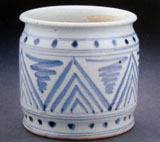- Museum Accession No.: EA2002.22
- Catalogue No.: 446
- Object type: Jar
- Kiln/Location: Blue-and-white, Arita
- Period/Date: 1652-58
- Dimensions: H. 9.7 cm, D. 10 cm
- Provenance: Story Fund
- Description: Small jar. Albarello shape, imitating a Delft original, with slightly everted rim and foot, no footring, unglazed base. Decoration of rows of dots above and below chevrons in underglaze blue. No space for label. Attributed to Shimoshirakawa kiln.
This is almost certainly one of the drug jars made to order for the VOC, for use rather than for resale. On 31 October 1652, the VOC shipped ' 1265 groote en cleijne medicament potten '('large and small medicine pots'; NFJ 776, fol. 16) to Taiwan, and on November 10, 1653, the VOC shipped '220 diverse porceleijn fleskens, potjens, zalfs en conserves potten voor Batavia, volgens 'overgesonden monsters alhier gemaeckt' ('various porcelain (small) bottles, (small) pots, salve and preserve pots for Batavia, made here according to the samples sent'; NFJ 775, fol. 35) to Batavia. This is the first recorded order for porcelain (as opposed to purchase) from Arita by the VOC. Other such pieces were shipped 'for the surgeon's shop in Batavia' in 1654, 1657 and 1658, and 'for the surgeon's shop in Taiwan' in 1656. In 1655 the destination is not mentioned. See Impey, 1996, pp. 132-39. Sherds of this shape and decoration have been found at two kiln-sites in Arita, Shimoshirakawa, where the foot is flat as in this example, and Sarugawa where the sherds have a footring. See Impey, 1996, fig. 80 for an example excavated in Amsterdam in a 1650s context (Baart, 1977, no. 550). For another example, see Idemitsu, 1990, no.458. For sherds from Sarugawa, see Impey, 1996, fig. 93. For a discussion of albanlli, with some reference to the present type, see no. 9. Had this recent purchase been made in time for the piece to be included in this catalogue, it could have been numbered either no. 0 (that is, in a new category before no. 1) or as no. 9A, depending upon whether the albarello no. 9 really is as early as we have suggested here.
- Exhibited:
- Similar Example:
- Illustrated:
|
Main View
|



